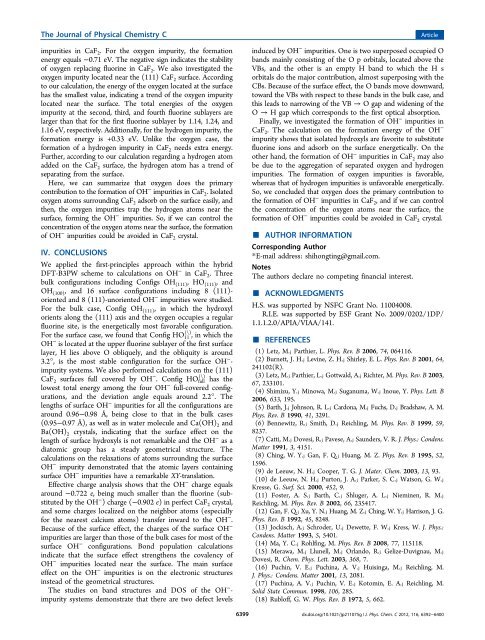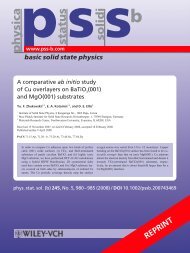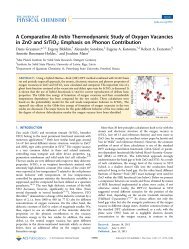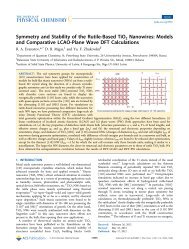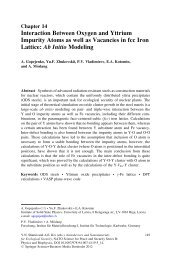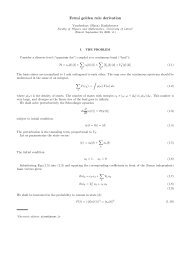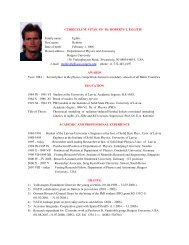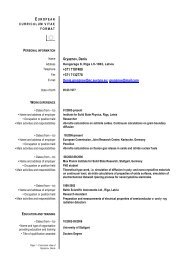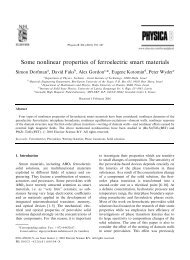Ab Initio Calculations of Hydroxyl Impurities in CaF2
Ab Initio Calculations of Hydroxyl Impurities in CaF2
Ab Initio Calculations of Hydroxyl Impurities in CaF2
You also want an ePaper? Increase the reach of your titles
YUMPU automatically turns print PDFs into web optimized ePapers that Google loves.
The Journal <strong>of</strong> Physical Chemistry CArticleimpurities <strong>in</strong> CaF 2 . For the oxygen impurity, the formationenergy equals −0.71 eV. The negative sign <strong>in</strong>dicates the stability<strong>of</strong> oxygen replac<strong>in</strong>g fluor<strong>in</strong>e <strong>in</strong> CaF 2 . We also <strong>in</strong>vestigated theoxygen impurity located near the (111) CaF 2 surface. Accord<strong>in</strong>gto our calculation, the energy <strong>of</strong> the oxygen located at the surfacehas the smallest value, <strong>in</strong>dicat<strong>in</strong>g a trend <strong>of</strong> the oxygen impuritylocated near the surface. The total energies <strong>of</strong> the oxygenimpurity at the second, third, and fourth fluor<strong>in</strong>e sublayers arelarger than that for the first fluor<strong>in</strong>e sublayer by 1.14, 1.24, and1.16 eV, respectively. Additionally, for the hydrogen impurity, theformation energy is +0.33 eV. Unlike the oxygen case, theformation <strong>of</strong> a hydrogen impurity <strong>in</strong> CaF 2 needs extra energy.Further, accord<strong>in</strong>g to our calculation regard<strong>in</strong>g a hydrogen atomadded on the CaF 2 surface, the hydrogen atom has a trend <strong>of</strong>separat<strong>in</strong>g from the surface.Here, we can summarize that oxygen does the primarycontribution to the formation <strong>of</strong> OH − impurities <strong>in</strong> CaF 2 .Isolatedoxygen atoms surround<strong>in</strong>g CaF 2 adsorb on the surface easily, andthen, the oxygen impurities trap the hydrogen atoms near thesurface, form<strong>in</strong>g the OH − impurities. So, if we can control theconcentration <strong>of</strong> the oxygen atoms near the surface, the formation<strong>of</strong> OH − impurities could be avoided <strong>in</strong> CaF 2 crystal.IV. CONCLUSIONSWe applied the first-pr<strong>in</strong>ciples approach with<strong>in</strong> the hybridDFT-B3PW scheme to calculations on OH − <strong>in</strong> CaF 2 . Threebulk configurations <strong>in</strong>clud<strong>in</strong>g Configs OH (111) ,HO (111) , andOH (100) , and 16 surface configurations <strong>in</strong>clud<strong>in</strong>g 8 (111)-oriented and 8 (111)-unoriented OH − impurities were studied.For the bulk case, Config OH (111) , <strong>in</strong> which the hydroxylorients along the (111) axis and the oxygen occupies a regularfluor<strong>in</strong>e site, is the energetically most favorable configuration.For the surface case, we found that Config HO (\) 11 , <strong>in</strong> which theOH − is located at the upper fluor<strong>in</strong>e sublayer <strong>of</strong> the first surfacelayer, H lies above O obliquely, and the obliquity is around3.2°, is the most stable configuration for the surface OH − -impurity systems. We also performed calculations on the (111)CaF 2 surfaces full covered by OH − . Config HO (\) full has thelowest total energy among the four OH − full-covered configurations,and the deviation angle equals around 2.2°. Thelengths <strong>of</strong> surface OH − impurities for all the configurations arearound 0.96−0.98 Å, be<strong>in</strong>g close to that <strong>in</strong> the bulk cases(0.95−0.97 Å), as well as <strong>in</strong> water molecule and Ca(OH) 2 andBa(OH) 2 crystals, <strong>in</strong>dicat<strong>in</strong>g that the surface effect on thelength <strong>of</strong> surface hydroxyls is not remarkable and the OH − as adiatomic group has a steady geometrical structure. Thecalculations on the relaxations <strong>of</strong> atoms surround<strong>in</strong>g the surfaceOH − impurity demonstrated that the atomic layers conta<strong>in</strong><strong>in</strong>gsurface OH − impurities have a remarkable XY-translation.Effective charge analysis shows that the OH − charge equalsaround −0.722 e, be<strong>in</strong>g much smaller than the fluor<strong>in</strong>e (substitutedby the OH − ) charge (−0.902 e) <strong>in</strong> perfect CaF 2 crystal,and some charges localized on the neighbor atoms (especiallyfor the nearest calcium atoms) transfer <strong>in</strong>ward to the OH − .Because <strong>of</strong> the surface effect, the charges <strong>of</strong> the surface OH −impurities are larger than those <strong>of</strong> the bulk cases for most <strong>of</strong> thesurface OH − configurations. Bond population calculations<strong>in</strong>dicate that the surface effect strengthens the covalency <strong>of</strong>OH − impurities located near the surface. The ma<strong>in</strong> surfaceeffect on the OH − impurities is on the electronic structures<strong>in</strong>stead <strong>of</strong> the geometrical structures.The studies on band structures and DOS <strong>of</strong> the OH − -impurity systems demonstrate that there are two defect levels6399<strong>in</strong>duced by OH − impurities. One is two superposed occupied Obands ma<strong>in</strong>ly consist<strong>in</strong>g <strong>of</strong> the O p orbitals, located above theVBs, and the other is an empty H band to which the H sorbitals do the major contribution, almost superpos<strong>in</strong>g with theCBs. Because <strong>of</strong> the surface effect, the O bands move downward,toward the VBs with respect to these bands <strong>in</strong> the bulk case, andthis leads to narrow<strong>in</strong>g <strong>of</strong> the VB → O gap and widen<strong>in</strong>g <strong>of</strong> theO → H gap which corresponds to the first optical absorption.F<strong>in</strong>ally, we <strong>in</strong>vestigated the formation <strong>of</strong> OH − impurities <strong>in</strong>CaF 2 . The calculation on the formation energy <strong>of</strong> the OH −impurity shows that isolated hydroxyls are favorite to substitutefluor<strong>in</strong>e ions and adsorb on the surface energetically. On theother hand, the formation <strong>of</strong> OH − impurities <strong>in</strong> CaF 2 may alsobe due to the aggregation <strong>of</strong> separated oxygen and hydrogenimpurities. The formation <strong>of</strong> oxygen impurities is favorable,whereas that <strong>of</strong> hydrogen impurities is unfavorable energetically.So, we concluded that oxygen does the primary contribution tothe formation <strong>of</strong> OH − impurities <strong>in</strong> CaF 2 , and if we can controlthe concentration <strong>of</strong> the oxygen atoms near the surface, theformation■<strong>of</strong> OH − impurities could be avoided <strong>in</strong> CaF 2 crystal.AUTHOR INFORMATIONCorrespond<strong>in</strong>g Author*E-mail address: shihongt<strong>in</strong>g@gmail.com.NotesThe authors declare no compet<strong>in</strong>g f<strong>in</strong>ancial <strong>in</strong>terest.■ ACKNOWLEDGMENTSH.S. was supported by NSFC Grant No. 11004008.R.I.E. was supported by ESF Grant No. 2009/0202/1DP/1.1.1.2.0/APIA/VIAA/141.■ REFERENCES(1) Letz, M.; Parthier, L. Phys. Rev. B 2006, 74, 064116.(2) Burnett, J. H.; Lev<strong>in</strong>e, Z. H.; Shirley, E. L. Phys. Rev. B 2001, 64,241102(R).(3) Letz, M.; Parthier, L.; Gottwald, A.; Richter, M. Phys. Rev. B 2003,67, 233101.(4) Shimizu, Y.; M<strong>in</strong>owa, M.; Suganuma, W.; Inoue, Y. Phys. Lett. B2006, 633, 195.(5) Barth, J.; Johnson, R. L.; Cardona, M.; Fuchs, D.; Bradshaw, A. M.Phys. Rev. B 1990, 41, 3291.(6) Bennewitz, R.; Smith, D.; Reichl<strong>in</strong>g, M. Phys. Rev. B 1999, 59,8237.(7) Catti, M.; Dovesi, R.; Pavese, A.; Saunders, V. R. J. Phys.: Condens.Matter 1991, 3, 4151.(8) Ch<strong>in</strong>g, W. Y.; Gan, F. Q.; Huang, M. Z. Phys. Rev. B 1995, 52,1596.(9) de Leeuw, N. H.; Cooper, T. G. J. Mater. Chem. 2003, 13, 93.(10) de Leeuw, N. H.; Purton, J. A.; Parker, S. C.; Watson, G. W.;Kresse, G. Surf. Sci. 2000, 452, 9.(11) Foster, A. S.; Barth, C.; Shluger, A. L.; Niem<strong>in</strong>en, R. M.;Reichl<strong>in</strong>g, M. Phys. Rev. B 2002, 66, 235417.(12) Gan, F. Q.; Xu, Y. N.; Huang, M. Z.; Ch<strong>in</strong>g, W. Y.; Harrison, J. G.Phys. Rev. B 1992, 45, 8248.(13) Jockisch, A.; Schroder, U.; Dewette, F. W.; Kress, W. J. Phys.:Condens. Matter 1993, 5, 5401.(14) Ma, Y. C.; Rohlf<strong>in</strong>g, M. Phys. Rev. B 2008, 77, 115118.(15) Merawa, M.; Llunell, M.; Orlando, R.; Gelize-Duvignau, M.;Dovesi, R. Chem. Phys. Lett. 2003, 368, 7.(16) Puch<strong>in</strong>, V. E.; Puch<strong>in</strong>a, A. V.; Huis<strong>in</strong>ga, M.; Reichl<strong>in</strong>g, M.J. Phys.: Condens. Matter 2001, 13, 2081.(17) Puch<strong>in</strong>a, A. V.; Puch<strong>in</strong>, V. E.; Kotom<strong>in</strong>, E. A.; Reichl<strong>in</strong>g, M.Solid State Commun. 1998, 106, 285.(18) Rubl<strong>of</strong>f, G. W. Phys. Rev. B 1972, 5, 662.dx.doi.org/10.1021/jp211075g | J. Phys. Chem. C 2012, 116, 6392−6400


